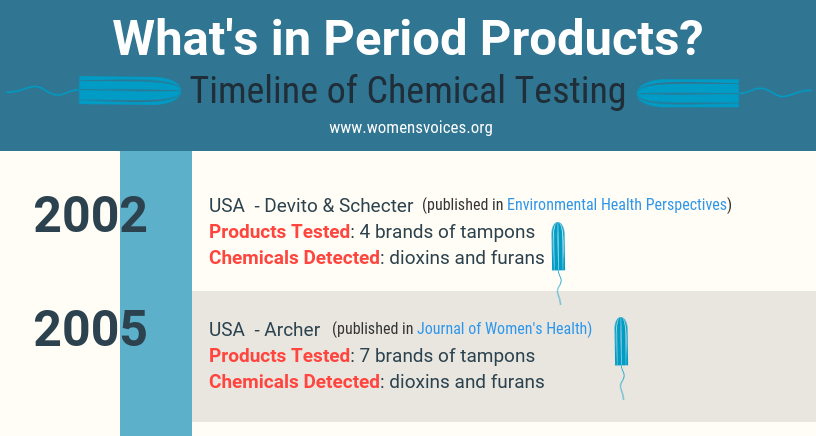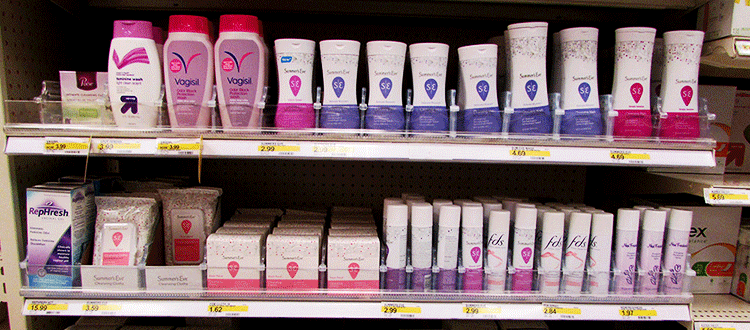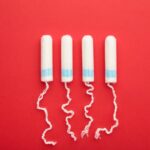published April 2019
Download Fact Sheet PDF
Nanosilver in Period Care Products
In recent years, the use of nanosilver as an antibacterial agent has greatly increased. Nanosilver is very small (microscopic) particles of silver. It is now commonly incorporated into athletic clothing to make it “antibacterial” in an effort to reduce odor. It has also been incorporated into certain period care products including absorbent menstrual underwear, and some menstrual pads (generally those pads marketed as containing an “anion strip” or other “ion technology”). It should be noted that while nanosilver is the most commonly used antibacterial agent in these products, some manufacturers do not specifically disclose that they are using silver, instead merely claiming that their products are “antibacterial”. The purpose, according to manufacturers, is to provide antibacterial properties to these products with the aim of decreasing the growth of “harmful” and/or odor-producing bacteria. Unfortunately, there are several adverse human health and environmental risks and concerns associated with nanosilver use. There are also several specific reasons that nanosilver may be especially inappropriate to use around sensitive vaginal and vulvar tissue.
Potential effects of nanosilver-containing period products on vaginal and vulvar tissue:
The immediate proximity of underwear and menstrual pads to vulvar tissue and vulvar/vaginal mucous membranes implies the possibility of migration of the antimicrobial agent to these highly sensitive tissues. Unfortunately, the potential health impacts of the migration of nanosilver to vaginal tissue are largely understudied and not well understood. The vaginal irritation tests commonly conducted as part of the safety testing for period products may not reflect the potential harms or impacts of nanosilver exposure.
1. Silver can have adverse impacts on beneficial vaginal bacteria.
The impact of antimicrobials such as nanosilver and/or ionic silver on the vaginal microbiome has never been studied directly. A healthy vaginal microbiome contains a delicate balance of numerous and diverse beneficial bacteria. A disruption of the microbial balance, can lead to overgrowth of harmful bacteria resulting in bacterial vaginosis, increased risk of sexually transmitted diseases, increased risk of pregnancy complications and other similar conditions.[1] One particular kind of bacteria, lactobacillus, is one of the most important beneficial bacteria types in a healthy vagina for most women.[2] There is some research available indicating that silver is an effective antimicrobial AGAINST lactobacilli, which is concerning. A recent study by the US Food and Drug Administration found that nanosilver was a very effective antibacterial that can kill two beneficial lactobacilli. [3] The two lactobacilli, (Lactobacillus delbrueckii subsp. bulgaricus and Lactobacillus casei) can both be found in the vaginal microbiome. Another study of nanosilver-containing dental resin found that nanosilver was very effective at eliminating lactobacilli in the mouth (associated with development of cavities). [4] A third study looked at the impact of nanosilver on beneficial probiotic lactobacillus found in fermented milk products. This study also found that nanosilver had significant impacts on reducing beneficial probiotic lactobacilli in these products. [5] To date there have been no studies published on the impact of nanosilver directly on the vaginal microbiome, but certainly this is research that is needed if silver antibacterials are to be used safely in vaginally adjacent products.
2. Nanosilver can also be cytotoxic, particularly to vaginal epithelial cells.
We identified one study that has been conducted examining the safety of nanosilver in vaginal applications. This study administered nanosilver vaginally in rabbits and examined the impacts on the vaginal tissue cells and the uptake of nanosilver into the body. The study found that the silver accumulated in vaginal tissues causing adverse ultrastructural changes to the vaginal mucosa, and promoted reactions toxic to vaginal cells. The researchers also found that vaginal administration of nanosilver led to migration of silver particles into the bloodstream, which could lead to systemic distribution around the body. [6] Further research on the potential impacts of these outcomes is needed.
3. Migration of nanosilver from period products into vaginal tissue and mucosa has never been studied.
Despite the significant recent increase in use of nanosilver as an antibacterial additive to menstrual products, there is no research available measuring the potential migration or absorption of nanosilver into vaginal tissue from product use. In response to concerns for the potential hazards of nanosilver migration from menstrual products, the FDA, with the support of the Office of Women’s Health, is now pursuing research in this area.[7] The study will, for the first time, examine the penetration and absorption of nanosilver into vaginal tissue and the toxic potential to the tissue and the vaginal microbiome from the use of menstrual products. Until this research is completed, manufacturers of nanosilver-embedded menstrual products are posing unknown risks to their customers.
4. Silver-treated athletic clothing has been implicated in several cases of thermal burns when worn during an MRI treatment.
MRI (magnetic resonance imaging) is a technique used for diagnosing and monitoring patients for a variety of diseases and conditions. As the technology involves high-powered magnets, patients are asked to remove anything metal from their bodies or clothing. There have been a few cases where patients have worn athletic clothing treated with silver, which resulted in a thermal burn to their skin as the metal in their clothing heated excessively during the procedure.[8][9][10] It is likely the patients, despite being warned about not wearing metal, might not have realized that silver was embedded in their clothing. Silver-containing menstrual underwear may pose a risk of vulvar burns to patients getting MRIs.
What companies are saying about their antibacterial period products:
“It’s not nanosilver, it’s ionic silver”
The difference between these two terms is not entirely clear. The purpose of adding silver (in whatever form) to a fabric is to release silver ions which effectively kill bacteria. Nanosilver is a form of very small-sized silver which easily releases silver ions, is not very expensive, and thus is commonly used. Any other form of silver, in order to be an effective antibacterial agent, will also release silver ions, thus posing risks of exposure.
“We use non-migratory silver embedded in the fabric which cannot migrate to vaginal tissue”
The migration of nanosilver has been a concern of environmental organizations for over a decade. The concern is that nanosilver particles are released from clothing into our environment (particularly in our waterways) where they are continuing to indiscriminately kill bacteria wherever they end up. This is of particular concern if they impact the beneficial bacteria that fish and other marine life rely on for survival. Several studies have been conducted to measure the release of nanosilver particles from athletic clothing – both from simulated wearing of the clothing, and from laundering the clothing. In every study thus far published, nanosilver has been documented to migrate from the clothing.[11][12][13] We have not identified any published studies demonstrating the success of non-migratory silver additives. And certainly, the period products themselves are not indestructible. Use and laundering of these products leads to release of lint (small flecks of fabric, which will contain silver if it is embedded within.) This silver-containing lint, is released to the environment as well posing risks.
“The silver we use is non-bioavailable, and will not be taken up by human or animal tissue.”
Some silver additives claim to be non-bioavailable as any ions are released are quickly transformed to more stable silver sulfide compounds, thought to be non-toxic. Unfortunately, the stability of silver sulfide under certain environmental conditions is being questioned in recent research[14], and there is new concern for the toxic effects to plants able to uptake silver sulfide through their roots.[15] The absorption and uptake of this type of silver from period products has never been studied. Whether it is truly non-bioavailable to humans has not been demonstrated. In any case, it still may pose an environmental impact down the line.
“Antibacterial fabric in our products will eliminate odor and protect your health.”
The effectiveness of silver-containing clothing to eliminate odor is highly debated. Yes, the silver kills bacteria, but online reviews do not indicate that gym clothes no longer need to be washed frequently. There is even less evidence that period products actually emit noticeable odors, or that silver containing ones emit less. There is no research indicating that period products such as menstrual underwear or pads are likely to transmit harmful bacteria to your body. (There is the potential for toxic shock syndrome related bacteria to be transmitted by tampon use. Toxic shock syndrome has never been documented to be caused by pads or underwear.) Thus, eliminating bacteria on a pad or underwear is a solution to a problem that does not exist, and one that comes with unnecessary risks. Instead of eliminating bacteria, we should be promoting and protecting the beneficial bacteria that are crucial to a healthy vagina.
Conclusion: Nanosilver in period products poses risks to our health and the environment and is simply an unnecessary addition.
Nanosilver is a current trend – which sounds “natural” and is marketed as being harmless while having benefits. Unfortunately, the research on the safety of nanosilver, particularly on exposure to vulvar and vaginal tissue is scant. Researchers who have conducted preliminary research on nanosilver are concerned about the impacts. Users of these products should not be accepting the risks of this unproven technology. Fortunately, menstrual underwear and pads can be equally effective and useful without an antibacterial layer. (Remember: the vast majority of regular women’s underwear and menstrual pads have no antibacterial properties – and they work too.)
What can you do?
- Ask the manufacturer of the products you use if they contain nanosilver (or silver of any kind) as an antibacterial additive. If they do – ask them to manufacture the product without the antibacterial layer.
- Support important right-to-know legislation like New York’s A.164/S.2387 [UPDATE: NY bill was signed into law in October 2019!] and the federal The Menstrual Products Right to Know Act (H.R. 2268) that require full disclosure of ingredients used to make period products including pads, tampons, cups and menstrual underwear.
- Support The Robin Danielson Feminine Hygiene Product Safety Act of 2019 (HB 3865), which directs the National Institute of Health to research the safety of period products, and the impact their ingredients are having on our health.
Download Fact Sheet PDF
———————————–
[1] https://www.ncbi.nlm.nih.gov/pubmed/28257809
Van de Wijgert, J. and Jespers V (2017) The global health impact of vaginal dysbiosis. Res Microbiol. 2017 Nov – Dec;168(9-10):859-864
[2] https://www.ncbi.nlm.nih.gov/pubmed/27492695
Lepargneur JP (2016) Lactobacillus crispatus as biomarker of the healthy vaginal tract. Ann Biol Clin (Paris). 2016 Aug 1;74(4):421-7.
[3] https://www.ncbi.nlm.nih.gov/pubmed/29481051
Tian X, Jiang X, Welch C, Croley TR, Wong TY, Chen C, Fan S, Chong Y, Li R, Ge C, Chen C, Yin JJ. (2018) Bactericidal Effects of Silver Nanoparticles on Lactobacilli and the Underlying Mechanism. ACS Appl Mater Interfaces. 2018 Mar 14;10(10):8443-8450.
[4] https://www.ncbi.nlm.nih.gov/pubmed/24790923
Kasraei S, Sami L, Hendi S, Alikhani MY, Rezaei-Soufi L, Khamverdi Z. (2014) Antibacterial properties of composite resins incorporating silver and zinc oxide nanoparticles on Streptococcus mutans and Lactobacillus. Restor Dent Endod. 2014 May;39(2):109-14.
[5] https://www.ncbi.nlm.nih.gov/pubmed/26766747
Mikiciuk J, Mikiciuk E, Wrońska A, Szterk A. (2016) Antimicrobial potential of commercial silver nanoparticles and the characterization of their physical properties toward probiotic bacteria isolated from fermented milk products. J Environ Sci Health B. 2016;51(4):222-9.
[6] https://www.ncbi.nlm.nih.gov/pubmed/26816649
Chen D, Yang Z. (2015) Tissue toxicity following the vaginal administration of nanosilver particles in rabbits. Regen Biomater. 2015 Dec;2(4):261-5
[7] https://www.fda.gov/ScienceResearch/SpecialTopics/WomensHealthResearch/ucm522681.htm
U.S. Food and Drug Administration (2018) OWH-Funded Research: Other. Available at: https://www.fda.gov/ScienceResearch/SpecialTopics/WomensHealthResearch/ucm522681.htm
[8] https://globalnews.ca/news/1452176/why-some-clothes-could-pose-a-safety-hazard-during-mri-exams/
[9] http://www.ajnr.org/content/ajnr/early/2012/03/01/ajnr.A2827.full.pdf
Pietryga JA, Fonder MA, Rogg JM, North DL, Bercovitch LG. (2012) Invisible Metallic Microfiber in Clothing Presents Unrecognized MRI Risk for Cutaneous Burn. AJNR Am J Neuroradiol. DOI: 10.3174/ajnr.A2827
[10] http://www.jmirs.org/article/S1939-8654(16)30002-9/fulltext
Heng Yang, H. Charette M, Talbot N. (2016) Do Magnetic Resonance Imaging Technologists in Canada Always Ask Patients to Change Before Examinations? Journal of Medical Imaging and Radiation Sciences. Vol. 47, No. 2, pp. 124-128.
[11] https://www.kemi.se/global/pm/2012/pm-1-12-antibact-en.pdf
Swedish Chemical Agency (2012) Antibacterial substances leaking out with the washing water–analyses of silver, triclosan and triclocarban in textiles before and after washing. Order No. 511 032. Available at: https://www.kemi.se/global/pm/2012/pm-1-12-antibact-en.pdf
[12] http://pubs.rsc.org/en/Content/ArticleLanding/2016/EN/C6EN00023A#!divAbstract
Mitrano DM, Limpiteeprakan P, Babelb S and Nowacka B (2016) Durability of nano-enhanced textiles through the life cycle: releases from landfilling after washing. Environmental Science: Nano. Issue 2. 2016.
[13] https://pubs.acs.org/doi/10.1021/nn502228w
Mitrano DM, Rimmele E, Wichser A, Erni R, Height M and Nowack B. (2014) Presence of Nanoparticles in Wash Water from Conventional Silver and Nano-silver Textiles. ACS Nano. Vol.8, No. 7, pp. 7208-7219. 2014.
[14] https://pubs.acs.org/doi/abs/10.1021/acs.est.5b03982
Li L, Wang Y, Liu Q, Jiang G. (2016) Rethinking Stability of Silver Sulfide Nanoparticles (Ag2S-NPs) in the Aquatic Environment: Photoinduced Transformation of Ag2S-NPs in the Presence of Fe(III). Environ Sci Technol. 2016 Jan 5;50(1):188-96.
[15] https://www.ncbi.nlm.nih.gov/pubmed/25686712
Wang P, Menzies NW, Lombi E, Sekine R, Blamey FP, Hernandez-Soriano MC, Cheng M, Kappen P, Peijnenburg WJ, Tang C, Kopittke P. (2015) Silver sulfide nanoparticles (Ag2S-NPs) are taken up by plants and are phytotoxic. Nanotoxicology. 2015;9(8):1041-9.








